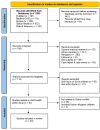Post-crisis health reality and wellbeing of children within Syria: a scoping review of research from 2012 to 2024
- PMID: 40604845
- PMCID: PMC12220813
- DOI: 10.1186/s13031-025-00673-1
Post-crisis health reality and wellbeing of children within Syria: a scoping review of research from 2012 to 2024
Abstract
Background: Syrian children, among the most vulnerable groups, have faced profound physical and psychological consequences due to the protracted conflict. This review assesses the health and well-being of children living within Syria, with particular attention to internally displaced populations (IDPs).
Objectives: To synthesize research on child health in Syria from 2012 to 2024, identify key health challenges, assess study characteristics and geographical distribution, and highlight gaps to inform future policies and interventions.
Design: We conducted a scoping review in December 2024 using the PRISMA-ScR (Preferred Reporting Items for Systematic Reviews and Meta-Analyses Extension for Scoping Reviews) methodology. We searched five academic databases (Medline Ovid, PubMed, Scopus, Web of Science, and Global Health) and selected studies published between January 2012 and December 2024. The search strategy followed the JBI Population–Concept–Context framework. Eligible studies included primary and secondary research, published in English or Arabic, that examined the health of children under 19 years old living within Syria in the context of the ongoing conflict. Grey literature was also retrieved from major organizational repositories (e.g., WHO, UNICEF, MSF, SAMS).
Results: A total of 1,189 records were retrieved, with 647 remaining after removing duplicates. After screening, 30 studies met the inclusion criteria. Most were observational, including cross-sectional (63.3%) and retrospective cohort (26.7%) designs. Surveys and medical records were the main data sources; oral examinations were common in dental studies, while anthropometry, blood tests, and interviews were less frequent. Data sources varied significantly by region (p < 0.001), with government-controlled areas relying on state institutions and non-government-controlled areas drawing on humanitarian data. Due to substantial heterogeneity, meta-analysis was not feasible. Notably, 80% of studies reported no external funding.
Conclusion: This review highlights major research gaps in child health within Syria, particularly among IDPs and in underserved regions. Most studies were observational, unfunded, and regionally concentrated, limiting broader applicability. Despite these constraints, this is the first comprehensive synthesis of health research focused on children within Syria, providing a foundation for future research, policy action, and targeted humanitarian interventions in conflict-affected settings.
Supplementary Information: The online version contains supplementary material available at 10.1186/s13031-025-00673-1.
Keywords: Child health; Conflict-Affected populations; Health services; Internally displaced persons (IDPs); Pediatric health; Public health; Syria.
Conflict of interest statement
Declarations. Ethics approval and consent to participate: Not applicable. Competing interests: The authors declare no competing interests.
Figures
Similar articles
-
Post-traumatic stress disorder, depression, anxiety, and their predictors among internally displaced persons in a conflict-affected area of Metekel Zone, Northwest Ethiopia: structural equation modeling.Front Psychiatry. 2025 Jun 13;16:1544289. doi: 10.3389/fpsyt.2025.1544289. eCollection 2025. Front Psychiatry. 2025. PMID: 40585533 Free PMC article.
-
The health of internally displaced people in Syria: are current systems fit for purpose?J Migr Health. 2022 Jul 21;6:100126. doi: 10.1016/j.jmh.2022.100126. eCollection 2022. J Migr Health. 2022. PMID: 35942086 Free PMC article.
-
In-person vs mobile app facilitated life skills education to improve the mental health of internally displaced persons in Nigeria: protocol for the RESETTLE-IDPs cluster randomized hybrid type 2 effectiveness-implementation trial.BMC Health Serv Res. 2024 Oct 22;24(1):1269. doi: 10.1186/s12913-024-11762-x. BMC Health Serv Res. 2024. PMID: 39438885 Free PMC article.
-
The health system in Syria (2000-2024): assembling the pieces of a fragmented system-A scoping review.Health Res Policy Syst. 2025 Jul 1;23(1):85. doi: 10.1186/s12961-025-01352-6. Health Res Policy Syst. 2025. PMID: 40598524 Free PMC article.
-
Common mental disorders and coping strategies amongst internally displaced Colombians: A systematic review.Glob Public Health. 2022 Dec;17(12):3440-3454. doi: 10.1080/17441692.2022.2049343. Epub 2022 Mar 8. Glob Public Health. 2022. PMID: 35259076
References
-
- Sahloul MZ, Monla-Hassan J, Sankari A, Kherallah M, Atassi B, Badr S, Abbara A, Sparrow A. War is the enemy of health. Pulmonary, critical care, and sleep medicine in War-Torn Syria. Ann Am Thorac Soc. 2016;13(2):147–55. - PubMed
-
- Syrian refugee crisis. facts, FAQs, and how to help [https://www.worldvision.org/refugees-news-stories/syrian-refugee-crisis-...]
Publication types
LinkOut - more resources
Full Text Sources
Miscellaneous





